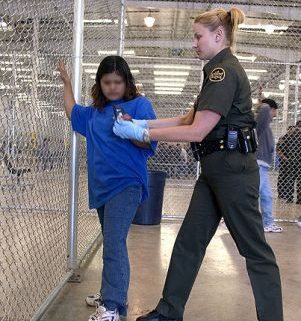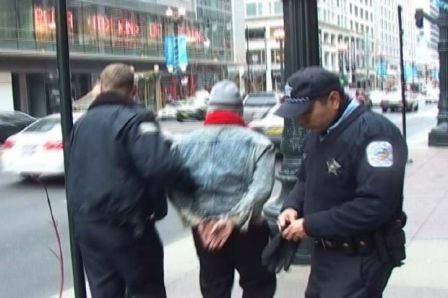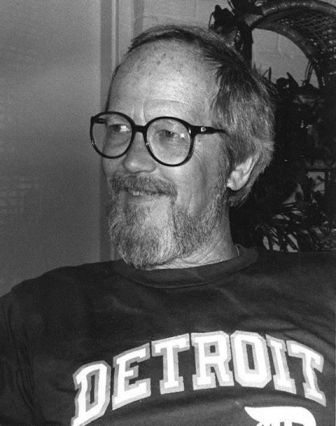Stop And Frisk: Legal, Or Not?
New York City has been feeling the heat for its stop and frisk policy, with many claiming the police department unfairly and unconstitutionally targets people of color. Maybe so, maybe no. I can’t speak to the NYPD’s situation because I don’t know their rules and regulations regarding the encounters. What I do know is that “stop and frisk” is indeed legal and it’s nothing new, not by any means. Here’s how it all began…
In the mid 1960’s, a Cleveland, Ohio detective (his last name was McFadden) saw two men, strangers to the area, walking back and forth in front of a store. On each pass the men stopped to look into the store window. McFadden watched the men while they made a couple of dozen trips past the storefront. After each trip by the business the two men stopped at the street corner to chat for a minute or two. Soon, a third man met the two men at the corner.
Well, Detective McFadden had seen enough to send his “cop radar” into overdrive. He was certain the men were “casing” the place, waiting for just the right moment to rob the store owner. So McFadden approached the three men at the corner, identified himself as a police officer, and then asked for their names. Someone mumbled something but no names were offered. Therefore, sensing things could quickly go downhill, McFadden spun on of the the mumblers around (John W. Terry) and patted the outside of his clothing, feeling a pistol in the man’s coat pocket.
Unable to retrieve the pistol on the street while keeping an eye on all three potential robbers, the detective ordered the men inside the store where he had them face the wall with their hands in the air. McFadden retrieved the pistol from the first suspect’s coat and then patted the clothing of the the other two men. During the searches McFadden located a second pistol. As a result, the three men were detained and taken to the police station. The two men with the guns were charged with possession of a concealed weapon.
On appeal, Terry argued that the officer had violated their constitutional rights according to the 4th amendment (unlawful search and seizure). However, the U.S Supreme Court ruled in favor of the officer, stating that his search was the minimum action required to see if the men were armed, a necessary tactic to safeguard his safety and the safety of others. And, that the suspects were indeed acting in a manner consistent with the probability of robbing the store owner.
Basically, the Court stated that whenever possible and practicable, a police officer must obtain a warrant to conduct a search and seizure. However, an exception must be made when “swift action” is required based on the observations of an officer.
Detective McFadden’s stop and frisk tactic has since been known as a Terry Stop.
The Terry Stop
Officers may, even without sufficient cause for arrest, briefly detain someone if…
– the officer identifies him/herself as a police officer (either by the uniform and badge, or verbally) and asks reasonable questions regarding the suspect’s current conduct.
– the officer has knowledge of facts that lead them to believe the suspect is involved in some sort of illegal activity.
– the person they’ve stopped does not immediately justify his actions in a manner that satisfies the officer’s suspicions.
Officer’s may conduct a pat-down search during a Terry Stop if they have a reasonable suspicion, based on personal knowledge of facts, that the person is armed. The Terry Stop is a search for weapons. Officers may not, however, go out on “fishing expeditions” under the guise of the Terry Stop. There must be facts supporting their reasons for a “frisk.”
By the way, a pat-down search is exactly as it sounds. Officers may only “pat” the outer surfaces of clothing. They may not reach into a person’s pockets unless they feel a weapon.
There is an exception to the rule, however, and that’s when an officer who has sufficient training and first-hand knowledge of narcotics packaging, “feels” what he/she suspects is a packet of drugs. The officer may then reach into the pocket to retrieve the packet. To do so, the officer must be able to testify under oath, and verify, that he/she has the sufficient experience and training that would give them the knowledge needed to identify narcotics packaging by feel. An example would be an officer who worked undercover or on a narcotics task force.
Okay, with that out of the way it’s time to visit New York City and the NYPD’s stop and frisk policy. Citizens are raising a ruckus because they don’t believe the department’s policy meets the standard of Terry v. Ohio, where an immediate action is required by the officer to protect himself or the safety of others. Nor do officers (according to citizen complaints) conduct these pat-down searches based on reasonable suspicion that a crime is about to take place.
Furthermore, many say NYPD officers simply stop people of color merely because they are indeed people of color who just happen to be walking along the street in a high crime area. And I must say that walking on a sidewalk in a high crime area is not in itself cause to warrant a Terry Stop.
Recently, Manhattan Federal Court Judge Shira Scheindlin ruled that the NYPD’s stop and frisk policy is unconstitutional, particularly when it comes to black and Hispanic males. Her ruling, though, does not mean that NYPD officers cannot conduct Terry Stops. What it does mean is that officers must follow the law to the letter and not detain and pat-down people without just cause. A person’s race, by the way, is not just cause.
Honestly, I don’t see the problem. If an officer’s assignment is to patrol a high crime area of the city, then it should be no problem to spot people who’re engaging in suspicious activity—drug dealers, robbers, rapists, car thieves, etc.—, especially in New York City.
I agree, police officers should not target anyone based on the color of their skin. To do so is very wrong. I do think, however, that officers should concentrate the majority of their proactive efforts in areas of the city that experiences the most crime, regardless of the race of the residents there—white, black, purple, or green. To do differently would be like fishing in a small pond. Sure, you might catch a fish or two, but there are far more in the ocean. That’s also where the big ones swim.
* * *
Elmore Leonard
1925 – 2013








Same here, Wally. Race was never an issue with me or my fellow officers. Thanks, too, for stopping by.
This is a matter of training and prosecutorial/court review. The department basic and field training is not being done very well if the procedures used on the streets are not meeting both officer safety and constitutional standards. The race aspect is just not credible to me. It would discredit the officers on the street, and not be effective by itself. The facts may be (I’m not there) that the people who are perceived by officers to possible be carrying are, by and large minorities. That is they dress, act ,and locate themselves in the place and manner officer have found weapons in the past. And remember, there is a vast array of weapons that can harm officers short of a gun that can be felt in pat downs, and leave lumps in clothes, that street geniuses miss. Also, these incidents are supposed to be reviewed by supervisors, prosecutors, and the lower courts. If the public is being unduly harassed surely these people would know about it and be complaining too. Finally I’m seeing some different numbers here than I have read elsewhere. I read that officers are finding “weapons” in one out of eight pat downs. As a twenty year patrol officer, that seem like a good record to me. Remember, we are acting on suspicion here. I am out there, maybe just me and one other officer, with a group of characters and what they look like (dress, manner, tattoos), the place, and the time of day are making me suspicious. They like to keep their hand in their pockets, even when I ask them not to, and they have attitude, and no reason to be where they are. I’m thinking about that weapon (gun puts them away, knife does not), whether its there or not, not the color of their skin. The white man is just as scary, in the dark. Most of the time, we talk, and they MOVE on, but sometimes, I see a lump in the clothing that could be, and they get to assume the position. I guess I flattered myself into thinking I was a professional seeking to enforce the law, not a racist oppressor.
This time, Steven, I sort of agree with you, in part. But only if the NYPD, or any other department, is conducting Terry Stops without reasonable suspicion that a crime is about to occur, or one has already taken place. Or, that there’s a reason for officers to fear for their safety or the safety of someone else. And those are huge factors that absolutely must come into play. If not, the searches are illegal and unconstitutional.
Like I said, though, I really can’t speak about the situation in NYC because I have no first-hand knowledge of their policy. I find it difficult to believe, though, that an agency of that size and depth, would initiate a policy that’s both illegal and unconstitutional.
Yes, Terry Stops do indeed work to help keep weapons out of the wrong hands. And it’s not just NYC where these stops are taking place. Officers all across the country do this every single day on every single shift. And, when done correctly, the stops work well as a proactive tool to prevent violence…meaning unnecessary killings, like innocent people killed during gang violence or drive-bys. You know, like the little kids killed when caught in a crossfire between two thugs arguing over a $10 chunk of crack.
I wish you’d take step back to have have a second look at the stats, with an impartial mindset. If, as you say, officers are finding guns only 2% of the time during Terry Stops, then I’d definitely call that a success. It means most people know not to carry weapons because the police are being very proactive when it comes to violent gun crimes. They will be arrested if police find an illegal weapon in their possession. Isn’t that what we want, to keep guns out of the wrong hands, the hands of gang members and violent offenders?
I don’t agree with using the stops to search for small quantities of drugs, though. That’s not the reason behind the Terry Stop, and to do so is illegal. I understand that part of the argument. What I don’t agree with is to allow criminals to walk the streets with weapons in their pockets unchecked.
Try this scenario on for size. You are now a police officer and it’s your job to patrol the area of the city where the majority of B&E’s, robberies, shootings, stabbings, and murders occur. It is your job to keep the citizens there safe from harm.
It’s 3am and you’re walking your beat, and suddenly you see three young black men heading in your direction. Two of the men are known for violence, especially gun violence (you work the beat so you know almost all the bad guys and gang members by name). The third man is a stranger to the area. You see one man place his right hand into his pants pocket. The pocket appears to contain a large object and his pants are sagging a bit to that side, indicating the object in the pocket is heavy. They have “the look” that they’re about to engage you in some sort of confrontation.
What do you do? Do you stop them to conduct a Terry Stop, or do you let them approach you unchecked and hope they’ll be sweet little angels and pass by on the way to grandma’s house with a pocket full of goodies.
Thirty minutes pass and you hear gunshots. You respond.
Do you feel guilty when you learn that the three men you encountered a half-hour earlier engaged in a shootout, a gun battle with rival gang members where a bullet fired from the gun of the guy with the “heavy pocket” cracked open the skull of a 7-year-old girl as she lay sleeping in her own bed in her own home? Is it your fault she’s dead? After all, you could have prevented it, but didn’t because you believe it’s wrong to stop anyone at all to conduct a quick pat down, even though you were reasonably certain you’d find a weapon. Is it a good thing that you’ve stood your ground and refused to stop someone because it is politically incorrect to stop someone of color?
Suppose the three men had been white and you’d encountered them in a rough white neighborhood? Would you have searched them?
Steven, the color of a person’s skin is irrelevant in relation to Terry Stops. What matters is that the stops work to keep some sort of check on gun violence and other crime. I don’t believe I could count the number of firearms I’ve confiscated during Terry Stops over the years. Many times, the bad guys tossed their guns and ran. Sometimes we’d catch them and others we wouldn’t. But we’d have their weapons. And, sometimes we’d run the guns through the system and learn that they’d been stolen or used during crime, such as murder.
Still, the stops must be conducted legally. I hope the NYPD is in line with the law. If not, well, that’s a wound that will take an awfully long time to heal.
Well, I think you know what I’m going to say, but I’ll say it anyway. Your description of a Terry Stop is wonderful, but far from what has been happening in NYC for more than a decade. Pat downs always ensue: if you’re a young black male, an officer asks “Yo, my man, can I talk to you?” at the same time they’re already feeling your pockets. Guns are rarely retrieved (2%? Less?). I know you see this as success, but the way you describe it above, “reasonable suspicion, based on personal knowledge of facts, that the person is armed” means that an officer’s “reasonable suspicion, based on personal knowledge of facts” can be trusted even if it’s wrong 98% of the time. I would say if an officer is going to be wrong 98% of the time and still pat himself on the back, he may have a skewed view of success.
Remember that millions of these searches have been conducted. More than 500k a year. There are young men in NYC who get frisked ten times a year. Imagine the amount of alienation the policy has caused. I’m willing to bet that a good percentage of the guys caught with weapons are carrying because they do live in bad neighborhoods and if they got into trouble, they sure as heck wouldn’t be calling the police (who feel good about being wrong 98% of the time).
The violent crime rates have fallen during Stop and Frisk… In just about the entire nation. If the rates have dropped in Boston without this policy or LA or anywhere, I’d like to know what they’re doing there. Could be worse, of course. But if crime rates drop with S&F and they drop without S&F, then maybe S&F is a non-factor.